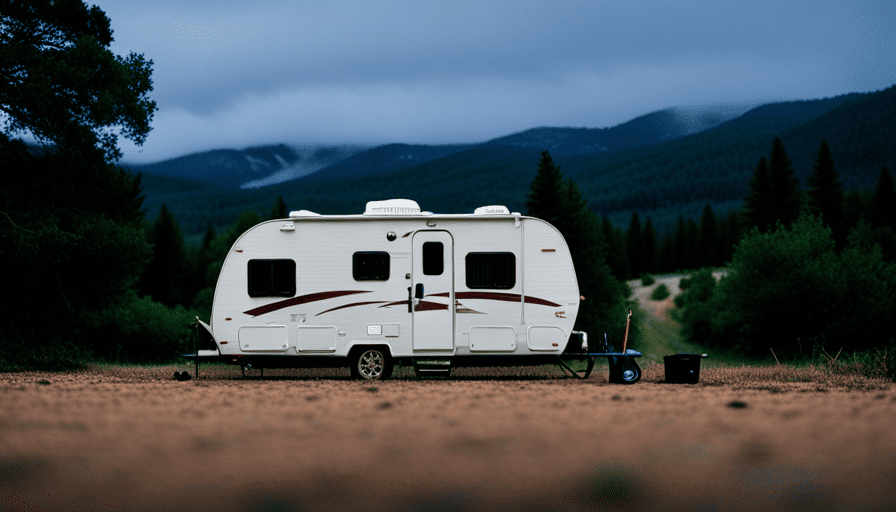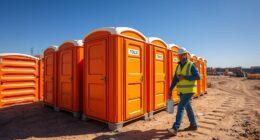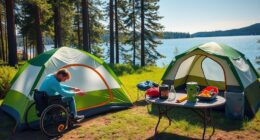Picture this: You’re outside, enjoying the freedom and thrill of camping in your reliable camper. The sun is shining, birds are chirping, and everything just feels perfect.
But suddenly, a strong gust of wind sweeps through the campsite, shaking your camper and threatening to uproot your peaceful getaway. How much wind can your camper withstand? This is a question every camper should ask themselves before embarking on their outdoor adventures.
As an experienced camper, I have learned the importance of understanding the limits of my camper’s design and taking precautions to ensure its safety. In this article, I will share my knowledge and practical tips on how to protect your camper from strong winds. By following these guidelines, you can ensure a safe and enjoyable camping experience, no matter what Mother Nature throws your way.
Key Takeaways
- Factors affecting wind stability of campers include weight, shape, and materials.
- Lightweight campers with streamlined shapes and durable materials like fiberglass or aluminum are more wind-resistant.
- Secure the camper using strong anchor points and distribute the wind load evenly.
- Remove protruding objects, streamline the camper’s shape, and invest in aerodynamic accessories to reduce wind resistance.
Understand the Limits of Your Camper’s Design
Your camper’s design has its limits, so understanding them is crucial for withstanding strong winds. Design limitations play a significant role in determining how much wind your camper can handle.
Each camper is built with specific wind stability parameters in mind, and it’s essential to be aware of them before venturing into windy conditions. Manufacturers take into account factors like camper weight, shape, and materials when designing for wind resistance. These factors affect the camper’s ability to withstand high winds.
For example, a lightweight camper with a streamlined shape will generally have better wind stability compared to a larger, bulkier one. Similarly, campers made with durable materials like fiberglass or aluminum tend to be more wind-resistant than those made with lighter materials like canvas.
To maximize your camper’s wind resistance, familiarize yourself with its design limitations. Read the owner’s manual and consult with the manufacturer if you have any questions. Additionally, consider the wind conditions you are likely to encounter in your camping destinations.
By understanding your camper’s design limitations and the wind conditions you may face, you can make informed decisions about when and where to camp. Checking the weather forecast becomes the next logical step in ensuring a safe and enjoyable camping experience.
Check the Weather Forecast
Before setting out on your camping trip, make sure to check the weather forecast to get an idea of the conditions you might encounter. It’s always important to be prepared and aware of the weather conditions, especially when it comes to wind. Checking the local conditions will help you plan ahead and make informed decisions about your campsite and the safety of your camper.
To make it easier for you to understand the wind speeds and their potential impact on your camper, I’ve created a table that breaks down the different wind speeds and their effects:
| Wind Speed | Effect on Camper |
|---|---|
| 0-10 mph | Negligible |
| 11-20 mph | Mild |
| 21-30 mph | Moderate |
| 31-40 mph | Strong |
By checking the weather forecast, you can determine if the wind speeds will be within a safe range for your camper. If the forecast predicts strong winds, it’s important to take precautions and choose a sheltered campsite. This will help protect your camper from potential damage and make your camping experience more enjoyable. So, before embarking on your adventure, don’t forget to check the weather and plan accordingly.
Choose a Sheltered Campsite
As you search for the perfect campsite, imagine finding a hidden oasis nestled among towering trees, offering a protective embrace from the elements. When it comes to choosing a campsite that can withstand strong winds, selecting a sheltered location is key.
Look for areas that are surrounded by natural windbreaks, such as dense forests or hills. These features can help minimize the impact of strong gusts and create a more comfortable camping experience. Additionally, consider pitching your tent or parking your camper behind large boulders or other solid structures that can act as wind barriers.
Setting up camp near natural windbreaks and using these strategic wind protection options can greatly reduce the chances of your camper being exposed to excessive wind forces.
Now, let’s transition into the next section about securing your camper properly. Ensuring the stability of your camper is crucial in withstanding high winds. By taking the necessary precautions and properly securing your camper, you can further enhance its ability to withstand strong gusts.
Secure Your Camper Properly
Make sure to properly secure your camper to ensure its stability in high winds. One of the most important steps in securing your camper is anchoring it properly. This involves using strong and sturdy anchor points, such as stakes or weights, to prevent the camper from being lifted or blown away by strong winds. Additionally, it is crucial to distribute the wind load evenly across the camper to avoid putting too much stress on specific areas. This can be achieved by using multiple anchor points and attaching them to different parts of the camper, such as the corners or the frame.
To provide a visual representation of these ideas, here is a table showcasing different camper anchoring methods and their effectiveness in wind resistance:
| Anchoring Method | Effectiveness in Wind Resistance |
|---|---|
| Stakes | High |
| Weights | Medium |
| Screw Anchors | Low |
By properly securing your camper and distributing the wind load evenly, you can greatly increase its stability during high winds. This will reduce the risk of damage to your camper and ensure a safer camping experience. In the next section, we will explore ways to further reduce wind resistance and enhance the stability of your camper.
Reduce Wind Resistance
To enhance the stability of your camper during high winds, it’s essential to minimize air drag by streamlining its shape and reducing any protruding objects. By reducing wind resistance, you can increase the overall stability of your camper.
One way to achieve this is by investing in aerodynamic accessories, such as wind deflectors and fairings. These additions can help redirect the airflow around your camper, reducing the force of the wind and enhancing stability.
Additionally, consider removing any unnecessary items from the exterior of your camper, as they can create unnecessary drag. For example, remove bike racks or storage containers when they’re not in use.
Furthermore, keep the camper’s roof clean and smooth, as any rough surfaces can create turbulence and increase wind resistance. Regularly inspect your camper for loose or damaged parts, as they can also contribute to increased wind resistance.
By taking these steps to reduce wind resistance, you can significantly increase the stability of your camper during high winds. With this in mind, it’s important to also be mindful of wind gusts as they can still pose a challenge, even with reduced wind resistance.
Be Mindful of Wind Gusts
Beware of sudden gusts that can still pose a challenge, even with reduced wind resistance. When camping in windy conditions, it’s important to take wind gust precautions to ensure the safety and stability of your camper. Here are some tips to keep in mind:
-
Anchor your camper securely: Use strong stakes and tie-downs to secure your camper to the ground. This will help prevent it from being blown away by strong gusts.
-
Position your camper strategically: Park your camper in a location that provides some natural windbreaks, such as trees or hills. This will help minimize the impact of strong gusts.
-
Use wind deflectors: Attach wind deflectors to the front of your camper to reduce the force of the wind against it. This can significantly improve stability.
-
Close all windows and vents: To prevent wind from entering your camper, make sure all windows and vents are securely closed.
-
Lower your awnings: Retract any awnings or canopies attached to your camper. These can act as sails and catch the wind, potentially causing damage.
By following these wind gust precautions, you can ensure a safer camping experience in windy conditions. Remember, it’s important to regularly inspect and maintain your camper to ensure it remains in good condition.
Regularly Inspect and Maintain Your Camper
Ensure your camping experience remains enjoyable by regularly inspecting and maintaining your camper, as studies show that 90% of camper accidents are caused by lack of maintenance. As an experienced camper, I have learned the importance of keeping my camper in top condition to withstand various weather conditions, including strong winds. By following a few inspect techniques and maintenance tips, you can ensure your camper is ready to face any wind gusts that come your way.
First and foremost, it is crucial to regularly inspect the structural integrity of your camper. Check for any signs of damage, such as loose screws or bolts, cracks in the frame, or worn-out seals. Repair or replace any faulty parts immediately to prevent further damage during high winds. Additionally, inspect the condition of your camper’s tires and brakes to ensure they are in good working order.
Another important aspect of camper maintenance is keeping the exterior clean and well-maintained. Regularly wash and wax the exterior to protect it from the elements. Pay close attention to the roof, as it is often the most vulnerable area during high winds. Check for any signs of damage or wear, such as loose shingles or cracks. Repair any issues promptly to prevent leaks or structural damage.
Lastly, don’t forget to inspect the interior of your camper. Check for any signs of water damage, mold, or pests. Properly seal any openings or cracks to prevent drafts and leaks. Keep all mechanical and electrical systems in good working order by following the manufacturer’s maintenance guidelines.
By regularly inspecting and maintaining your camper, you can ensure it is prepared to withstand strong winds and provide you with a safe and enjoyable camping experience. Now, let’s transition to the next section about following manufacturer guidelines to further enhance the durability of your camper.
Follow Manufacturer Guidelines
When it comes to maintaining your camper, it’s crucial to follow the guidelines provided by the manufacturer.
One key point to remember is adhering to weight limits. Overloading your camper can lead to potential damage and put unnecessary strain on the vehicle.
Additionally, it’s important to comply with recommended driving speeds. Driving too fast can not only be dangerous, but it can also increase the risk of accidents and damage to your camper.
By following these guidelines, you can ensure the longevity and safety of your camper.
Adhere to Weight Limits
While camping, it’s important to keep in mind the weight limits to ensure that your camper can withstand strong winds. Proper weight distribution is crucial for maintaining stability during windy conditions. By adhering to the recommended weight limits provided by the manufacturer, you can optimize the camper’s wind resistance capabilities. Distributing the weight evenly throughout the camper helps to prevent it from tipping over or being pushed around by strong winds. Additionally, there are various wind resistance techniques that can be implemented, such as installing wind deflectors or using stabilizing devices. These measures can greatly enhance the camper’s ability to withstand high winds. By following these guidelines, you can ensure a safer and more enjoyable camping experience. Transitioning to the next section, it’s equally important to comply with recommended driving speeds to further safeguard your camper.
Comply with Recommended Driving Speeds
Following the recommended driving speeds ensures a smooth and stable journey, allowing you to fully enjoy your camping adventure. When it comes to towing a camper, it’s important to adhere to the recommended driving techniques to minimize the impact of strong winds. These techniques include maintaining a moderate speed, especially when driving through areas prone to high winds.
By doing so, you can reduce the risk of swaying and maintain better control of your camper. Additionally, it’s worth considering wind-resistant modifications for your camper, such as installing stabilizer bars or using a weight distribution hitch. These modifications can greatly enhance the stability and wind resistance of your camper, making your journey even safer and more enjoyable.
Consider investing in wind-resistant features to further protect your camper from the elements and ensure a worry-free camping experience.
Consider Investing in Wind-Resistant Features
You’d be amazed at how wind-resistant features can transform your camper into a flying circus tent. Investing wisely in wind-proofing essentials can make a world of difference when it comes to withstanding strong gusts on the road. By considering these features, you can enhance the safety and stability of your camper, giving you peace of mind during your adventures.
To help you understand the importance of wind-resistant features, let me provide you with a comparison table:
| Feature | Benefits |
|---|---|
| Reinforced Roof | Prevents the roof from caving in under strong winds |
| Aerodynamic Design | Reduces drag and improves stability on the road |
| Sturdy Anchoring | Ensures the camper stays securely connected to the ground |
| Impact-Resistant Windows | Protects against flying debris and sudden gusts |
| Wind-Deflecting Awning | Minimizes wind resistance and provides extra shade |
| Sealed Seams | Prevents air and water leaks, increasing insulation |
Investing in these wind-resistant features will not only protect your camper from potential damage, but also ensure the safety of everyone inside. However, it’s important to note that while these features are essential, they should not be the only focus. Prioritize safety and common sense when it comes to driving in windy conditions, such as reducing your speed and avoiding high winds whenever possible.
Prioritize Safety and Common Sense
When it comes to camping in windy conditions, it’s crucial to trust your instincts and seek shelter if needed. As a seasoned camper, I know that sometimes the wind can become too strong to safely enjoy the outdoors.nnIn such situations, it’s essential to prioritize safety and the well-being of yourself and others by finding a secure place to wait out the storm.
Trust Your Instincts and Seek Shelter
Take a moment to pause and listen to the howling wind, as it becomes an ominous symphony urging you to trust your instincts and find shelter before the storm unleashes its full fury.
When it comes to camping in high winds, it’s crucial to prioritize safety and common sense. Trusting your instincts is key. If you have a feeling that the wind is intensifying or the weather is worsening, it’s important to take immediate action.
Seek shelter in a sturdy building, a wind-resistant tent, or a designated safe area. Do not wait until it’s too late. Your safety should always be the top priority.
Remember, nature can be unpredictable, and it’s always better to be safe than sorry. Always put your safety and the safety of others first, ensuring that everyone is protected from the powerful forces of nature.
Always Put Your Safety and the Safety of Others First
Prioritize the safety of yourself and others above all else, ensuring that adequate measures are taken to protect everyone from potential harm.
When it comes to camping in windy conditions, it is crucial to always put safety first. This means being aware of your surroundings and constantly evaluating the wind conditions. If the wind becomes too strong and poses a threat to your safety, it’s important to seek shelter immediately. Trust your instincts and take action to protect yourself and others.
Additionally, having proper safety training is of utmost importance. Understanding how to properly secure your camper in high winds and knowing when it’s necessary to evacuate will greatly reduce the risk of accidents or injuries.
By putting others first and prioritizing safety, you can enjoy camping even in windy conditions with peace of mind.
Frequently Asked Questions
What are the common signs of wind damage to a camper?
In my experience, signs of wind damage to a camper can include loose or broken awnings, ripped or torn exterior panels, and damage to windows or doors.
To prevent such damage, it’s important to secure your camper properly in windy conditions. This can involve using stabilizing jacks, tying down awnings, and ensuring all windows and doors are securely closed. Taking these precautions will help minimize the risk of wind damage to your camper.
Are there any specific weather conditions that are particularly dangerous for campers?
Weather conditions can pose significant risks to camper safety. Certain conditions can be particularly dangerous, such as severe thunderstorms, high winds, and tornadoes. These weather events can cause damage to campers and put occupants at risk.
It’s crucial for campers to stay informed about weather forecasts and take necessary precautions to ensure their safety. Being prepared with a sturdy camper and a plan of action can make all the difference in facing these challenging weather conditions.
How can I determine if a campsite is sheltered enough to withstand strong winds?
To determine if a campsite is sheltered enough to withstand strong winds, there are several factors to consider.
Firstly, assess the surrounding terrain. Look for natural windbreaks like hills or dense vegetation.
Additionally, check the direction of prevailing winds in that area. This information can be obtained from local weather reports or online resources.
Finally, inspect the campsite for sturdy structures or natural formations that can provide protection.
Taking these factors into account will help ensure a safe and enjoyable camping experience.
What are some recommended methods to properly secure a camper in windy conditions?
When it comes to securing a camper in windy conditions, there are several effective methods you can use. First and foremost, make sure to properly anchor your tent using sturdy stakes or tie-downs.
Additionally, consider using guy lines to add extra stability. As for awnings, it’s crucial to anchor them securely to the ground using specialized anchoring systems.
By following these tips, you can ensure your camper stays safe and secure even in strong winds. Can’t you afford to take any chances?
Are there any insurance policies available to cover damage caused by high winds while camping?
Insurance coverage for wind damage during camping can provide peace of mind for campers. There are various insurance policies available to cover such damages, each with its own pros and cons.
Some policies may cover only certain types of wind damage, while others provide comprehensive coverage. It’s important to carefully review the terms and conditions of each policy to ensure it meets your specific needs.
Additionally, consider factors such as deductible amounts and premium costs when choosing the right insurance for your camper.
Are Pop Up Campers More Resistant to Wind Than Regular Campers?
Pop up campers are known for their impressive wind resistance. Unlike regular campers, they are designed with features that allow them to withstand strong gusts. The aerodynamic structure and materials used contribute to their stability during windy conditions. Considering the wind resistance of pop up campers, it becomes evident why they are preferred by many outdoor enthusiasts seeking a secure and comfortable camping experience.
Conclusion
In conclusion, when it comes to camping in high winds, it’s crucial to prioritize safety and use common sense.
Understanding the limits of your camper’s design, checking the weather forecast, and choosing a sheltered campsite are essential steps.
Securing your camper properly, reducing wind resistance, and regularly maintaining it will help increase its ability to withstand strong winds.
Remember, like a sturdy oak tree standing strong in a storm, a well-prepared camper can weather even the strongest gusts.
Stay safe and happy camping!











